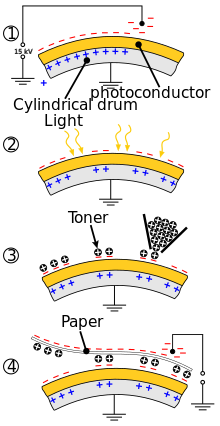How a photocopier works (using xerography)
Sunday, February 1, 2009
There are two main types of copy machines, xerographic and electrostatic. Both use the same process to make a copy but they each do it in a slightly different way.
2. Exposure: A bright lamp illuminates the original document, and the white areas of the original document reflect the light onto the surface of the photoconductive drum. The areas of the drum that are exposed to light (those areas that correspond to white areas of the original document) become conductive and therefore discharge to ground. The area of the drum not exposed to light (those areas that correspond to black portions of the original document) remain negatively charged. The result is a latent electrical image on the surface of the drum. (In digital machines, the original document is scanned and digitized and a laser is employed to discharge the drum in a similar fashion)
3. Developing: The toner is positively charged. When it is applied to the drum to develop the image, it is attracted and sticks to the areas that are negatively charged (black areas), just as paper sticks to a toy balloon with a static charge.
4. Transfer: The resulting toner image on the surface of the drum is transferred from the drum onto a piece of paper with a higher negative charge than the drum.
5. Fusing: The toner is melted and bonded to the paper by heat and pressure rollers.
6. Cleaning: The drum is wiped clean with a rubber blade and completely discharged by light.
This example is of a negatively charged drum and paper, and positively charged toner as is common in today's digital copiers. Some copiers, mostly older analog copiers, employ a positively charged drum and paper, and negatively charged toner.
Read more...
